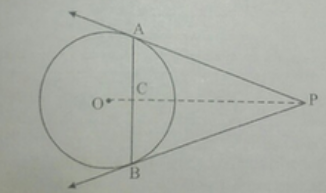If a number of circles pass through the end points P and Q of a line segment PQ, then Prove that their centres lie on the perpendicular bisector of PQ.
To prove that the centers of all circles passing through the endpoints P and Q of a line segment PQ lie on the perpendicular bisector of PQ, we can follow these steps:
Step 1: Define the Points
Let the points P and Q be defined in a Cartesian coordinate system. Assume:
- P = (x1, y1)
- Q = (x2, y2)
Step 2: Find the Midpoint of PQ
The midpoint M of the line segment PQ can be calculated using the midpoint formula:
M=(x1+x22,y1+y22)
Step 3: Find the Slope of PQ
The slope of the line segment PQ can be found using the formula:
slope of PQ=y2−y1x2−x1
Step 4: Find the Slope of the Perpendicular Bisector
The slope of the perpendicular bisector of PQ will be the negative reciprocal of the slope of PQ. Thus:
slope of perpendicular bisector=−x2−x1y2−y1
Step 5: Equation of the Perpendicular Bisector
Using point-slope form, the equation of the perpendicular bisector can be written as:
y−y1+y22=−x2−x1y2−y1(x−x1+x22)
Step 6: General Equation of a Circle
The general equation of a circle with center (h, k) and radius r can be expressed as:
(x−h)2+(y−k)2=r2
Step 7: Condition for Circle to Pass Through P and Q
For the circle to pass through points P and Q, the following conditions must hold:
1. For point P:
(x1−h)2+(y1−k)2=r2
2. For point Q:
(x2−h)2+(y2−k)2=r2
Step 8: Set Up the Equations
Since both equations equal r2, we can set them equal to each other:
(x1−h)2+(y1−k)2=(x2−h)2+(y2−k)2
Step 9: Simplify the Equation
Expanding both sides and simplifying gives us:
(x12−2hx1+h2+y12−2ky1+k2)=(x22−2hx2+h2+y22−2ky2+k2)
Step 10: Cancel Common Terms
Cancel h2 and k2 from both sides:
x12−2hx1+y12−2ky1=x22−2hx2+y22−2ky2
Step 11: Rearranging the Terms
Rearranging the terms leads to:
2h(x2−x1)+2k(y2−y1)=x22−x12+y22−y12
Step 12: Conclusion
This equation shows that the coordinates (h, k) of the center of the circle depend linearly on the coordinates of P and Q, confirming that the center lies on the perpendicular bisector of PQ.
Let the points P and Q be defined in a Cartesian coordinate system. Assume:
- P = (x1, y1)
- Q = (x2, y2)
The midpoint M of the line segment PQ can be calculated using the midpoint formula:
M=(x1+x22,y1+y22)
The slope of the line segment PQ can be found using the formula:
slope of PQ=y2−y1x2−x1
The slope of the perpendicular bisector of PQ will be the negative reciprocal of the slope of PQ. Thus:
slope of perpendicular bisector=−x2−x1y2−y1
Using point-slope form, the equation of the perpendicular bisector can be written as:
y−y1+y22=−x2−x1y2−y1(x−x1+x22)
The general equation of a circle with center (h, k) and radius r can be expressed as:
(x−h)2+(y−k)2=r2
For the circle to pass through points P and Q, the following conditions must hold:
1. For point P:
(x1−h)2+(y1−k)2=r2
2. For point Q:
(x2−h)2+(y2−k)2=r2
Since both equations equal r2, we can set them equal to each other:
(x1−h)2+(y1−k)2=(x2−h)2+(y2−k)2
Expanding both sides and simplifying gives us:
(x12−2hx1+h2+y12−2ky1+k2)=(x22−2hx2+h2+y22−2ky2+k2)
Cancel h2 and k2 from both sides:
x12−2hx1+y12−2ky1=x22−2hx2+y22−2ky2
Rearranging the terms leads to:
2h(x2−x1)+2k(y2−y1)=x22−x12+y22−y12
This equation shows that the coordinates (h, k) of the center of the circle depend linearly on the coordinates of P and Q, confirming that the center lies on the perpendicular bisector of PQ.
Topper's Solved these Questions
- BOOK - NCERT EXEMPLAR ENGLISHCHAPTER - CIRCLESEXERCISE - EXERCISE 9.3 SHORT ANSWER TYPE QUESTIONS10videos
CIRCLES
- BOOK - NCERT EXEMPLAR ENGLISHCHAPTER - CIRCLESEXERCISE - EXERCISE 9.4 LONG ANSWER TYPE QUESTIONS14videos
CIRCLES
- BOOK - NCERT EXEMPLAR ENGLISHCHAPTER - CIRCLESEXERCISE - EXERCISE 9.4 LONG ANSWER TYPE QUESTIONS14videos
CIRCLES
- BOOK - NCERT EXEMPLAR ENGLISHCHAPTER - ARITHMETIC PROGRESSIONSEXERCISE - Long Answer Type Questions10videos
ARITHMETIC PROGRESSIONS
- BOOK - NCERT EXEMPLAR ENGLISHCHAPTER - CONSTRUCTIONSEXERCISE - Exercise 10.4 Long Answer type Questions7videos
CONSTRUCTIONS
Similar Questions
If a number of circles pass through the end points P and Q of a line segment PQ, then prove their centres lie on the perpendicular bisector of PQ.
View SolutionDraw a line segment PQ=4.8 cm.
Construct the perpendicular bisector of PQ.View SolutionConstruct the perpendicular bisector of the line segment PQ.
View SolutionDraw a line segment PQ length 8.4 cm. Draw the perpendicular bisector of this line segment.
View SolutionIf two circles intersect in two points, prove that the line through the centres is the perpendicular bisector of the common chord.
View SolutionDraw a line segment PQ of length 8.4cm. Draw the perpendicular bisector of this line segment.
View SolutionDraw a line segment PQ of length 7 cm. from a point M outside PQ, drop a perpendicular to PQ.
View SolutionFrom an external point P, two tangents PA and PB are drawn to the circle with centre O. Prove that OP is the perpendicular bisector of AB.
 View Solution
View SolutionDraw a line segment PQ. Take any point A on it. Draw a perpendicular to PQ through A.
View SolutionProve that the locus of a point equidistant from the extermities of a line segment is the perpendicular bisector if it.
View Solution

